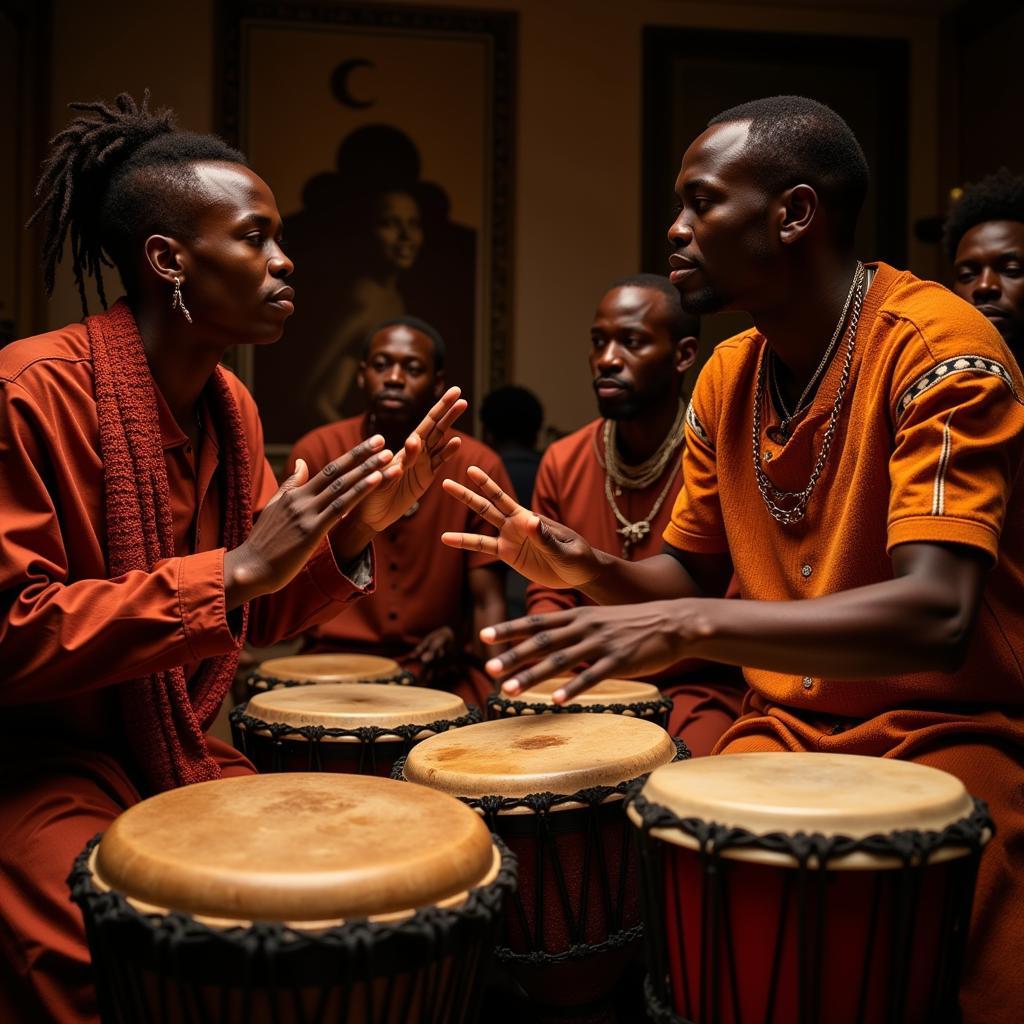African Folk Art Animals: A Journey Through Culture and Creativity
African Folk Art Animals burst with vibrant colors, bold designs, and deeply symbolic meanings. These captivating creations offer a glimpse into the rich tapestry of African cultures and their unique relationship with the animal kingdom. From intricate wood carvings to colorful beaded sculptures, each piece tells a story, embodies a belief, or honors the spirits of the wild.
The Significance of Animals in African Culture
Across the African continent, animals hold a revered place in cultural beliefs and traditions. They are often seen as totems, ancestors, and messengers between the human and spiritual realms. This profound connection is vividly expressed through the diverse forms of African folk art.
For example, the lion, often depicted with a majestic mane and powerful stance, represents strength, courage, and leadership. The elephant, known for its wisdom and longevity, symbolizes wisdom, family, and strength. Birds, with their ability to soar through the air, often embody freedom, spirituality, and the connection between the earthly and divine. african folktales tradition These animals, along with a menagerie of other creatures, are not merely decorative elements but serve as powerful symbols woven into the fabric of African folklore, rituals, and daily life.
Materials and Techniques: From Earth to Art
African folk artists draw inspiration from their surroundings, transforming natural materials into captivating expressions of cultural heritage. Wood, clay, textiles, beads, and even recycled objects find new life as animal forms.
Wood Carving: A Legacy of Skill and Storytelling
Wood carving holds a place of honor among African art forms. Passed down through generations, this skilled craft produces intricate masks, sculptures, and utilitarian objects adorned with animal imagery. In West Africa, the Yoruba people are renowned for their elaborate masquerade traditions, where intricately carved masks representing various animal spirits play a central role in rituals and festivals.
Beadwork: Vibrant Colors, Intricate Details
Beadwork, another prominent form of African folk art, transforms tiny beads into intricate and colorful representations of animals. From small beaded animals to large, elaborate sculptures, each piece reflects the patience, skill, and artistic vision of the creator. The Maasai people of East Africa are particularly famous for their vibrant beadwork, often using animal motifs to adorn clothing, jewelry, and ceremonial objects.
Regional Styles and Traditions
Just as the animal kingdom is diverse, so too are the styles and traditions of African folk art. Each region of this vast continent boasts unique aesthetics, materials, and cultural interpretations of animal symbolism.
West Africa: Bold Colors and Dynamic Forms
West African folk art is known for its bold colors, dynamic forms, and often incorporates intricate details and symbolic patterns. The use of recycled materials, particularly metal, is also common, showcasing the resourcefulness and creativity of the artists. african elephant on white background
Southern Africa: Natural Materials and Expressive Forms
Southern African folk art often features natural materials like wood, clay, and grass. The art from this region tends towards more abstract and expressive forms, capturing the essence of the animal rather than aiming for strict realism.
East Africa: Vibrant Beadwork and Textile Traditions
East Africa is renowned for its vibrant beadwork and textile traditions. The Maasai, Samburu, and other ethnic groups incorporate intricate beadwork and colorful fabrics into their clothing and accessories, often featuring stylized animal motifs. african crocodile
African Folk Art Animals in the Modern World
Today, African folk art animals continue to captivate audiences worldwide. From museums and art galleries to online marketplaces and fair trade shops, these captivating creations have found a place in homes and collections far beyond their countries of origin.
“African folk art offers a window into the soul of a culture,” says Dr. Abena Agyeman, a renowned art historian specializing in African art. “These pieces are not merely decorative objects but tangible expressions of history, belief systems, and the profound relationship between humans and the natural world.”
african folk songs for elementary choir The enduring appeal of African folk art animals lies in their ability to transcend cultural boundaries. They invite us to appreciate the beauty of different cultures, to connect with the natural world, and to contemplate the timeless stories embedded within each piece. african animal and plants Whether a whimsical beaded bird or a powerful wooden mask, African folk art animals offer a tangible link to the rich artistic heritage and cultural traditions of the African continent.
FAQ
Q: What is the significance of animals in African folk art?
A: Animals hold deep cultural and spiritual significance in many African cultures. They are often seen as totems, ancestors, or messengers between the human and spiritual realms.
Q: What materials are commonly used in African folk art animals?
A: Common materials include wood, clay, beads, textiles, metal, and even recycled objects.
Q: Where can I buy authentic African folk art animals?
A: Reputable online marketplaces, fair trade shops, and art galleries specializing in African art are good places to start your search.
Q: How can I learn more about the symbolism behind specific African folk art animals?
A: Researching specific cultures and their beliefs, consulting with art historians, and visiting museums with African art collections are all helpful approaches.
Need Help?
For assistance, please contact us at Phone Number: +255768904061, Email: kaka.mag@gmail.com. Or visit us at: Mbarali DC Mawindi, Kangaga, Tanzania. We have a 24/7 customer service team.



